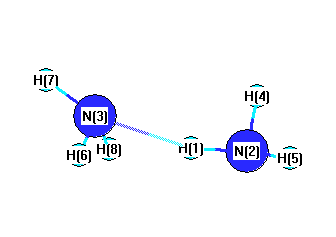Vibrational Frequencies calculated at PBEPBEultrafine/3-21G
| Mode Number |
Symmetry |
Frequency
(cm-1) |
Scaled Frequency
(cm-1) |
IR Intensities
(km mol-1) |
Raman Act
(Å4/u) |
Dep P |
Dep U |
|---|
| 1 |
Ag |
3389 |
3358 |
0.00 |
|
|
|
| 2 |
Ag |
3193 |
3164 |
0.00 |
|
|
|
| 3 |
Ag |
1711 |
1696 |
0.00 |
|
|
|
| 4 |
Ag |
1045 |
1036 |
0.00 |
|
|
|
| 5 |
Ag |
621 |
615 |
0.00 |
|
|
|
| 6 |
Ag |
245 |
243 |
0.00 |
|
|
|
| 7 |
Au |
3442 |
3411 |
4.17 |
|
|
|
| 8 |
Au |
1747 |
1731 |
26.14 |
|
|
|
| 9 |
Au |
390 |
386 |
89.36 |
|
|
|
| 10 |
Au |
171 |
169 |
45.80 |
|
|
|
| 11 |
Bg |
3441 |
3410 |
0.00 |
|
|
|
| 12 |
Bg |
1732 |
1716 |
0.00 |
|
|
|
| 13 |
Bg |
251 |
249 |
0.00 |
|
|
|
| 14 |
Bu |
3390 |
3359 |
36.08 |
|
|
|
| 15 |
Bu |
3226 |
3196 |
203.62 |
|
|
|
| 16 |
Bu |
1667 |
1651 |
10.58 |
|
|
|
| 17 |
Bu |
848 |
840 |
480.66 |
|
|
|
| 18 |
Bu |
215 |
213 |
460.08 |
|
|
|
Unscaled Zero Point Vibrational Energy (zpe) 15361.6 cm
-1
Scaled (by 0.9909) Zero Point Vibrational Energy (zpe) 15221.8 cm
-1
See section
III.C.1 List or set vibrational scaling factors
to change the scale factors used here.
See section
III.C.2
Calculate a vibrational scaling factor for a given set of molecules
to determine the least squares best scaling factor.
Charges, Dipole, Quadrupole and Polarizability
Charges from optimized geometry at PBEPBEultrafine/3-21G
Charges (e)
| Number |
Element |
Mulliken |
CHELPG |
AIM |
ESP |
| 1 |
H |
0.285 |
|
|
|
| 2 |
N |
-0.800 |
|
|
|
| 3 |
N |
-0.800 |
|
|
|
| 4 |
H |
0.257 |
|
|
|
| 5 |
H |
0.257 |
|
|
|
| 6 |
H |
0.285 |
|
|
|
| 7 |
H |
0.257 |
|
|
|
| 8 |
H |
0.257 |
|
|
|
Electric dipole moments
Electric dipole components in Debye
(What's a Debye? See section
VII.A.3)
| |
x |
y |
z |
Total |
| |
0.000 |
0.000 |
0.000 |
0.000 |
| CHELPG |
|
|
|
|
| AIM |
|
|
|
|
| ESP |
|
|
|
|
Electric Quadrupole moment
Quadrupole components in D Å
Polarizabilities
Components of the polarizability tensor.
Units are
Å
3 (Angstrom cubed)
Change units.
| |
x |
y |
z |
| x |
0.000 |
0.000 |
0.000 |
| y |
0.000 |
0.000 |
0.000 |
| z |
0.000 |
0.000 |
0.000 |
<r2> (average value of r
2) Å
2
| <r2> |
56.156 |
| (<r2>)1/2 |
7.494 |
